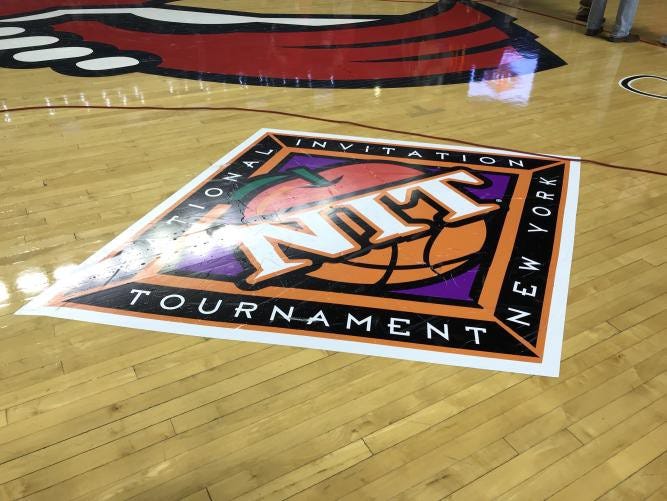WKU Basketball: How Do the NIT Rule Changes Affect WKU?
Western Kentucky men’s basketball impressed once again on Tuesday, dispatching an underrated Boston College team with a ton of young…
Western Kentucky men’s basketball impressed once again on Tuesday, dispatching an underrated Boston College team with a ton of young talent, 79–62.
One of the major story lines heading into Tuesday’s game was the experimental rules changes. The NCAA announced four rules changes for the NIT in 2018:
Teams will play four ten minute quarters instead of two halves of 20 minutes. Double bonus free throws after five teams fouls, resetting each quarter.
The free throw lane will be widened from 12 feet to the NBA standard, 16 feet.
The three-point line will be extended an extra 20 inches, using the FIBA approved distance used in international competition. The line is now at 22 feet, 1.75 inches.
The offensive shot clock resets to 20 seconds after an offensive rebound.
How Does This Affect the Tops?
In his post-game press conference Tuesday night, Stansbury said he was a big fan of the quarters and felt it helped the flow of the game. He went on to say he felt widening the lane made very little difference, and he joked, “Three point line? That didn’t really affect us. You know that. We don’t even look at it.” His only issue with the rules was free throws; as he put it, his teams draws a lot of fouls, and it is a big disadvantage for WKU to shoot less at the line.
Digging deeper, WKU could stand to benefit significantly from these rules changes. Why? Each of these are designed to speed the game up, make it more exciting for fans and the rules should frankly help the teams with more talent and athleticism. WKU is one of the more high-flying, penetrating teams in the country.
Widening the lane allows for more flow on the interior. Justin Johnson and Dwight Coleby generally set up outside of the NBA lane when they post up, anyway. Guards Darius Thompson, Lamonte Bearden and Taveion Hollingsworth should have more room to drive the lane. WKU is good at penetrating the lane, and the NBA lane is designed for more opportunities in the middle.
WKU held Boston College to 20 total points in the middle two quarters. Having shorter quarters allows coaches to break down the game into fathomable quadrants instead of trying to manufacture four minute segments five times in each half. With longer breaks in between each timeout, when the game gets going, it flows until a break, when teams can regroup. On the radio post-game interview, Stansbury mentioned using the bench less because players could rest during breaks. That’s huge for a team with nine total players available. Clearly, having quarters affects WKU positively.
The offensive shot clock does take away the massive effect of an offensive rebound late in a game. WKU had a possession late in the fourth when it nabbed three in a row. Instead of potentially burning two minutes, WKU could only have burned a minute and a half with those three rebounds. However, this offensive shot clock forces WKU to get moving again after a rebound.
With a 30 second clock, the Toppers have tended to send the ball back out front, dribble until ten seconds remain on the clock, and attempt to take the opponent one-on-one with Hollingsworth, Thompson or Bearden. Early in the game, WKU struggled to get the feel for how to play with ten less seconds. Overall, this should actually be really positive for WKU and force the Toppers to use their instincts on the offensive boards.
No matter where the three point line is, three pointers tend to affect the teams that shoot them. WKU’s offensive really should not look any different, but WKU’s opponents should be affected. That being said, Boston College was in the Top 50 in three pointers attempted, and it didn’t seem to amount to much of a difference Tuesday.
Moving Forward
Fourth-seeded WKU heads to Los Angeles to take on a talented top-seeded USC team that found a way against a game UNC-Asheville in double overtime at home. 6'10" Chimezie Metu, a likely first round NBA draft pick, sat out Tuesday against UNCA.
USC should also benefit from the rules changes. USC has more NBA-caliber athleticism and shoots over 37% from the three point line. Similar to WKU, the Trojans shoot significantly more free throws than its opponent and nearly makes as many as its opponent attempts. Bonus situations could be interesting if the game is tightly called.
Certainly with Metu sitting out, WKU should be comparable inside offensively, and with guards that can penetrate, maybe this is a decent match-up for WKU.
With the rules changes, WKU needs to do what it does best: Drive to the hole and pass if someone gets in the way. If the Hilltoppers can get to the rim often, USC should have a difficult battle on their home court for the right to play in the NIT quarterfinals.





